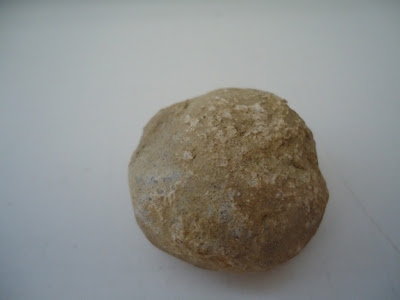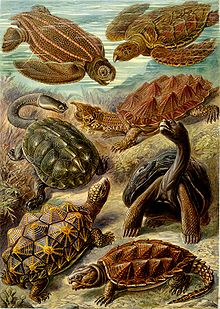The first proto-turtles are believed to have existed in the late Triassic Period of the Mesozoic era, about 220 million years ago, and their shell, which has remained a remarkably stable body plan, is thought to have evolved from bony extensions of their backbones and broad ribs that expanded and grew together to form a complete shell that offered protection at every stage of its evolution, even when the bony component of the shell was not complete. This is supported by fossils of the freshwater Odontochelys semitestacea or "half-shelled turtle with teeth", from the late Triassic, which have been found near Guangling[disambiguation needed] in southwest China. Odontochelys displays a complete bony plastron and an incomplete carapace, similar to an early stage of turtle embryonic development.[10] Prior to this discovery, the earliest-known fossil turtles were terrestrial and had a complete shell, offering no clue to the evolution of this remarkable anatomical feature. By the late Jurassic, turtles had radiated widely, and their fossil history becomes easier to read.
However, it was later suggested the anapsid-like turtle skull may be due to reversion rather than to anapsid descent. More recent morphological phylogenetic studies with this in mind placed turtles firmly within diapsids, slightly closer to Squamata than to Archosauria.[12][13] All molecular studies have strongly upheld the placement of turtles within diapsids; some place turtles within Archosauria,[14] or, more commonly, as a sister group to extant archosaurs,[15][16][17][18] though an analysis conducted by Lyson et al. (2012) recovered turtles as the sister group of lepidosaurs instead.[19] Reanalysis of prior phylogenies suggests they classified turtles as anapsids both because they assumed this classification (most of them studying what sort of anapsid turtles are) and because they did not sample fossil and extant taxa broadly enough for constructing the cladogram. Testudines were suggested to have diverged from other diapsids between 200 and 279 million years ago, though the debate is far from settled.[12][15][20] Even the traditional placement of turtles outside Diapsida cannot be ruled out at this point. A combined analysis of morphological and molecular data conducted by Lee (2001) found turtles to be anapsids (though a relationship with archosaurs couldn't be statistically rejected).[21] Similarly, a morphological study conducted by Lyson et al. (2010) recovered them as anapsids most closely related to Eunotosaurus.[22] A molecular analysis of 248 nuclear genes from 16 vertebrate taxa suggest that turtles are a sister group to birds and crocodiles (the Archosauria).[23] The date of separation of turtles and birds and crocodiles was estimated to be 255 million years ago. The most recent common ancestor of living turtles, corresponding to the split between Pleurodira and Cryptodira, was estimated to have occurred around 157 million years ago. This last estimate may conflict with the fossil record depending on whether the genus Kayentachelys, whose fossils date to around 190 million years ago, is the earliest known member of Cryptodira[24] or lies outside the least inclusive clade containing Cryptodira and Pleurodira.[25][26]
source:





No comments:
Post a Comment